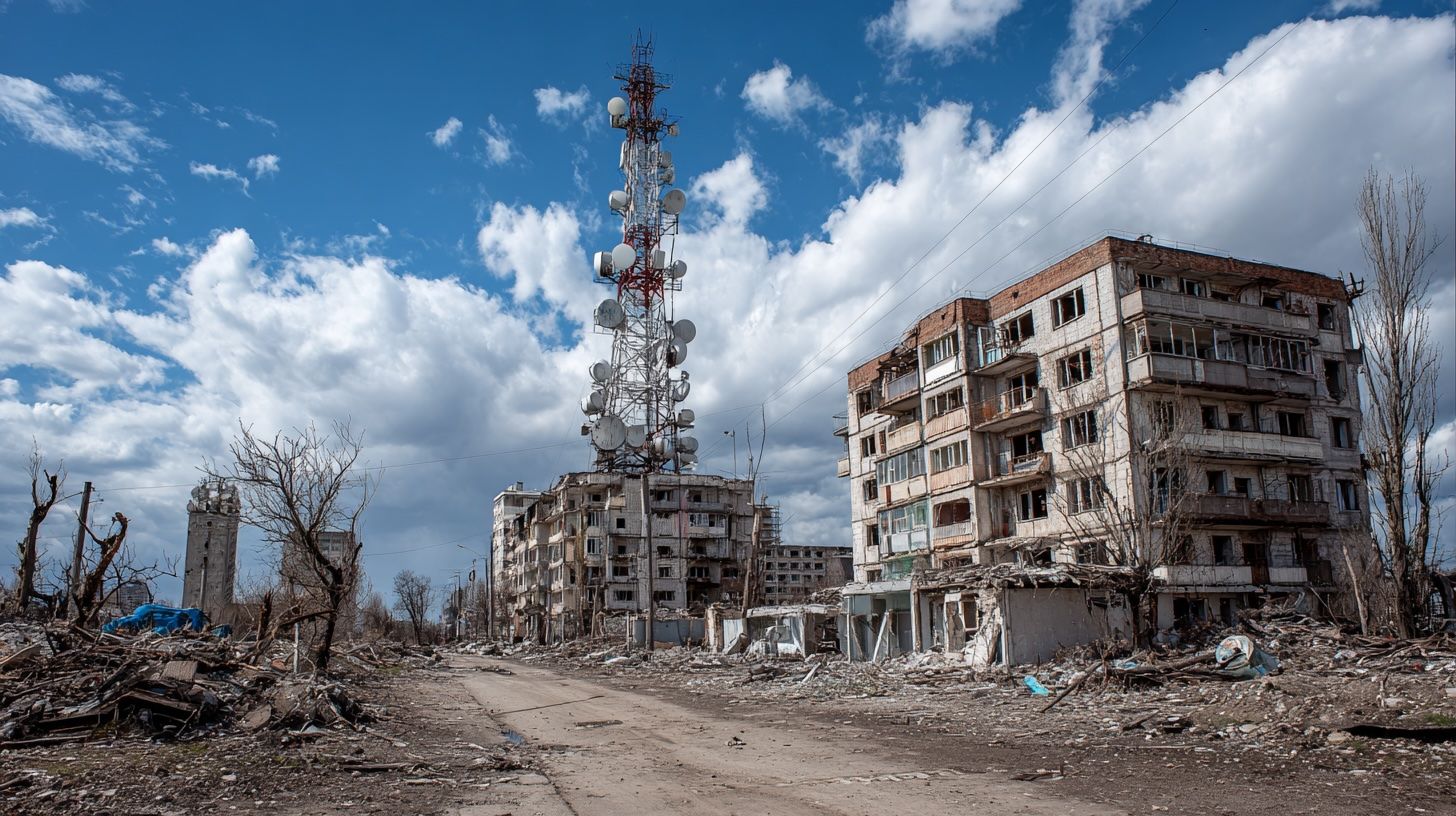Overview: Types of Infrastructure Targeted
Ukraine’s telecommunications network encompasses a wide range of critical infrastructure that has come under attack since 2022. These include:
- Mobile network infrastructure: Thousands of cellular base stations and transmission towers (the physical masts and antennae that provide 3G/4G mobile coverage) have been damaged or destroyed [1] [2]. Key mobile switching centers and equipment shelters have also been hit by shelling.
- Fixed internet backbone: Fiber-optic trunk lines and regional internet exchange nodes have been severed in combat zones. Over a quarter of Ukraine’s fixed broadband network has been knocked offline [3] [4]. Underground fiber cables – totaling tens of thousands of kilometers – have been cut or damaged by explosions and digging (sometimes intentionally by occupying forces) [5] [6].
- Broadcasting facilities: Television and radio broadcast towers have been prime targets. At least 18 major broadcasting masts were destroyed, silencing TV/radio in those areas [7]. This includes iconic structures like the Kyiv TV Tower, struck by a Russian missile on March 1, 2022, and the 240-meter Kharkiv TV tower, which was broken in half by an airstrike in April 2024 [8] [9].
- Satellite and data networks: Russia’s assault extended to satellite communications as well. On February 24, 2022 (the invasion’s first day), a cyberattack knocked out Viasat’s KA-SAT satellite network, disrupting internet service in Ukraine and parts of Europe [10]. Ground stations and satellite uplinks have faced jamming attempts [11]. Data centers and telecom switching offices in conflict areas have been looted or destroyed, and operators sometimes pre-emptively sabotaged equipment to keep it from enemy hands [12].
Together, these attacks have aimed to sever Ukraine’s connectivity – both civilian communications and military command links – by dismantling the physical pillars of the internet, phone, and broadcast systems. The following sections detail the timeline of destruction, the regional impacts, and how Ukraine has kept communications running against the odds.
Chronology of Major Damage (2022–2025)
People examine the wreckage of a broadcasting tower destroyed by a Russian missile strike in Kharkiv (April 2024) [13]. Critical telecom facilities – from TV towers to fiber hubs – have been repeatedly targeted since 2022.
2022 – Initial Invasion and Outages: Russia’s full-scale invasion in February 2022 immediately disrupted Ukrainian telecom services. In the opening days (Feb 24–25, 2022), heavy bombardment caused internet blackouts in cities like Kharkiv and Mariupol, while cyberattacks took down satellite links [14] [15]. A Russian missile strike on March 1, 2022 hit the Kyiv TV Tower, killing broadcasters and briefly knocking major TV channels off-air [16]. By early March, entire regions experienced communication outages – for example, a battle-damaged power substation caused a telecom blackout across Sumy Oblast on March 3 [17] [18]. The port city of Mariupol was “almost completely” knocked offline under siege by the end of February [19]. Ukraine’s main internet backbone operators also suffered: an attack on provider GigaTrans disrupted connectivity near Kyiv on Feb 26 [20] [21]. By March 2022, roughly 500 mobile base stations were offline due to power cuts or damage in combat zones [22].
Mid/Late 2022 – Systematic Targeting: Through summer and fall 2022, Russian forces continued to degrade communications especially in occupied territories. Retreating occupiers often severed or confiscated telecom equipment – “the first thing the Russians do… is deprive people of communication,” noted a Ukrainian official [23] [24]. In areas like Kherson, Melitopol, and Mariupol, Ukrainian mobile networks were switched off and replaced with Russian-run carriers, creating an information blackout [25] [26]. Deliberate attacks on telecom continued: on Oct 10, 2022, a day of mass missile strikes, Russian rockets hit telecommunications offices in eastern Ukraine, killing at least four communications workers [27]. That fall, Russia launched a sustained campaign against Ukraine’s power grid; these rolling blackouts knocked out cell towers and internet nodes for hours or days at a time. By November 2022, parts of Kyiv, Lviv, Odesa, and Zaporizhzhia had no electricity or connectivity for days after heavy bombardment of infrastructure [28] [29]. Telecom outages became widespread – Ukraine faced 276 distinct internet disruptions in 2022, totaling 19,000 hours of downtime, especially in front-line and occupied areas [30] [31].
2023 – Continued Strikes and Blackouts: In 2023, even as Ukraine restored service to liberated areas, Russian attacks on infrastructure persisted. The damage to telecom infrastructure increased by ~29% from 2022 to 2023 [32]. Through the winter of 2022–23, repeated missile barrages on the energy grid caused nationwide power outages – these forced telecom operators into emergency mode, running thousands of cell towers on generators. At times, over half of mobile network base stations were down due to lack of power [33]. Frontline regions like Donetsk, Luhansk, Kherson, and Zaporizhzhia saw ongoing shelling that destroyed cell towers and exchanges as fighting seesawed. For example, during Ukraine’s counter-offensive in Kharkiv and Kherson, engineers found entire local networks in ruins, requiring complete rebuilding [34] [35]. Throughout 2023, cyber warfare also continued: over 1,100 cyberattacks have targeted the ICT sector since the war’s start [36], including attacks on ISP offices and attempts to reroute internet traffic to Russian-controlled networks [37]. Despite this, Ukraine managed to reconnect many freed towns – by October 2022 Ukraine had restored 1,232 base stations in liberated areas that Russia had knocked out [38], and that effort only grew in 2023.
2024 – High-Profile Strikes on Telecom: Russia showed no sign of relenting in 2024. A dramatic example came on April 22, 2024, when a cruise missile struck Kharkiv’s main TV tower, shearing the structure in half [39] [40]. This deliberate attack on Ukraine’s second-largest city aimed to “limit Kharkiv’s access to communication and information,” President Zelenskyy said [41]. Remarkably, no staff were killed (they had taken shelter), but digital TV broadcasts were temporarily knocked out [42] [43]. Throughout 2024, critical telecom and energy sites remained under fire – analysts recorded 389 attacks on critical infrastructure (energy and comms) in 2024 alone [44]. Russian forces also increasingly targeted Ukraine’s expanding use of SpaceX Starlink satellite links, attempting to jam satellite internet signals used by the Ukrainian military [45]. By late 2024, telecom damage was compounded by nearly two years of warfare, prompting urgent calls for reconstruction (Ukraine estimated $4.7 billion needed over the next decade to fully rebuild the telecom sector) [46].
Early 2025 – Ongoing Conflict and Connectivity: As of mid-2025, sporadic attacks are still causing damage. In January 2025, for instance, over 40 strikes on critical infrastructure were recorded (some undoubtedly affecting telecom sites) [47]. Frontline cities like Bakhmut and Avdiivka, under relentless assault, have seen communications “reduced to rubble” along with other utilities [48]. Nonetheless, Ukraine’s telecom networks have adapted to be more survivable – despite new incidents, no nationwide blackout has occurred. Roughly 88% of Ukraine’s mobile base stations remain operational even amid the conflict [49] [50]. The chronology of destruction is still unfolding, but Ukraine’s measures to mitigate outages (described below) have kept much of the country online against the odds.
Regional Impact: Hardest-Hit Areas
Telecom destruction has not been uniform – it mirrors the intensity of fighting and occupation. Eastern and southern Ukraine have borne the brunt:
- Donetsk Oblast: With protracted battles (Mariupol, Bakhmut, Avdiivka, etc.), Donetsk region accounts for about 17% of all telecom infrastructure damage nationwide [51]. Many cell towers, telephone exchanges, and TV towers in Donbas were destroyed by shelling. Long sieges (like Mariupol) led to complete communication outages in early 2022 [52], and much of the fixed network remains inoperative under Russian occupation or active combat.
- Kharkiv Oblast: Also around 17% of total telecom damage has occurred in Kharkiv region [53]. The city of Kharkiv, Ukraine’s second-largest, had its TV tower repeatedly attacked (in March 2022 and finally destroyed in April 2024) [54]. Extensive fiber-optic cables running through the oblast (near the Russian border) have been cut. During Russia’s occupation of parts of Kharkiv oblast in 2022, entire communities were cut off until Ukrainian forces restored mobile service in liberated towns [55] [56].
- Kherson and Zaporizhzhia Oblasts: These southern regions each saw roughly 11–13% of the total telecom damage [57]. In Kherson, Russian troops physically rerouted internet traffic through Crimea and Russia, and destroyed infrastructure as they retreated in late 2022 [58] [59]. Large swathes of rural Kherson had no Ukrainian mobile or internet until networks were rebuilt after liberation. Zaporizhzhia, partly occupied (including the critical Enerhodar and Melitopol areas), suffered extensive fiber cuts and cell tower destruction as well. The ongoing threat around the Zaporizhzhia nuclear plant also caused intermittent loss of communications for safety systems [60].
- Kyiv Oblast: The capital region (about 11–12% of telecom damage [61]) was an early target. Beyond the Kyiv TV tower attack, the suburban telecom cables and cell sites around Bucha, Irpin, and Hostomel were devastated during Russia’s failed assault on Kyiv in Feb–March 2022. While Kyiv city’s core networks were restored relatively quickly, the region continues to be hit by drone and missile attacks on power/utility sites that indirectly disrupt telecom. For example, power station strikes have at times knocked out internet service to parts of Kyiv region until generators kicked in.
- Other regions: Luhansk, Mykolaiv, and Odesa oblasts have also sustained significant damage, especially where fighting raged or Russian occupation occurred. In Luhansk, an almost complete communications blackout ensued after Sievierodonetsk and Lysychansk were overrun in mid-2022, with networks there still largely down. In Mykolaiv, intense shelling in 2022 damaged telecom hubs, though quick repairs kept the regional center online. Odesa (though farther from front lines) saw its internet exchanges disrupted by power outages and a major Russian drone attack on a telecom building in 2023 (as reported by regional officials).
Overall, the heaviest destruction correlates with war’s front lines. Donetsk and Kharkiv have the highest absolute losses, followed by Zaporizhzhia, Kherson, and the Kyiv area [62]. Occupied territories experienced not only physical destruction but also deliberate dismantling: occupying forces confiscated equipment or forced Ukrainian ISPs to switch to Russian networks and country codes, effectively erasing Ukrainian signals from those areas [63] [64]. This regional breakdown underscores that restoring connectivity is most urgent in the East and South, where damage is greatest and service restoration is often dependent on military developments on the ground.
The War’s Toll in Numbers
Quantitative data illustrates the scale of telecommunications losses since 2022:
- Mobile network damage: Over 4,300 mobile base stations (cell tower sites) have been destroyed or heavily damaged by fighting as of early 2024 [65] [66]. This is roughly one quarter of all base stations nationwide. By comparison, about 11% of mobile base stations were offline by May 2022 [67]; that figure has grown as the war continued. The government reports around 12% of Ukrainian households have lost mobile service entirely due to the destruction [68].
- Fixed-line and internet infrastructure: Approximately 25% of fixed broadband network facilities have been destroyed or rendered inoperable [69] [70]. More than 30,000 km of fiber-optic cable running across Ukraine have been cut or damaged in combat [71]. (Initial estimates in 2022 were even higher – including cables in occupied zones, up to 60,000 km of fiber was impacted [72].) Major internet backbone providers suffered outages – e.g. Ukraine’s connectivity dropped sharply (by ~16%) in the first weeks of invasion and 17% of network-connected devices nationwide became unreachable [73]. Some regions lost the majority of internet access: Kherson’s accessible IP addresses fell by 81%, and Donetsk’s by 59%, relative to pre-war levels [74].
- Broadcast and communication towers: At least 18 broadcast transmission towers (for TV and radio) were destroyed by Russian strikes through 2022 [75], with more hit in 2023–2024 (e.g. local TV masts in frontline towns). The iconic towers in Kyiv and Kharkiv were among those attacked [76] [77]. These strikes disrupted free-to-air TV/radio, though services often resumed via backups within days.
- Service outages: From the war’s start to early 2023, analysts logged 276 distinct internet outages of varying scope across Ukraine, totaling nearly 19,000 hours of disrupted connectivity [78]. Of these, 45 were severe blackouts (e.g. city- or region-wide) lasting a combined 3,800+ hours [79]. The longest outages were in areas under occupation – for instance, Kherson region endured almost 1,500 hours of Internet blackout before liberation [80].
- Economic cost: The World Bank estimated by the end of 2023 that about $2.1 billion in direct damage had been inflicted on Ukraine’s telecom sector [81]. Ukraine’s government projects a larger need for full recovery, factoring in modernization – about $4.7 billion over 10 years will be required to rebuild and upgrade the telecom/network infrastructure [82]. Meanwhile, the digital sector’s indirect losses (lost revenues, etc.) are estimated over $19 billion [83] [84]. Telecom companies have collectively spent tens of millions of dollars on repairs already (e.g. Vodafone Ukraine spent ₴2 billion to fix 900 sites, and Lifecell $150 million on 1,000 repairs) [85] [86]. Hundreds of smaller local ISPs have been financially devastated – 720 providers have suffered major losses, and nearly 100 face bankruptcy due to the war’s impact [87].
These figures highlight both the breadth of destruction (from thousands of cell sites to nationwide internet shrinkage) and the resilience – even under bombardment, the majority of Ukraine’s communications have stayed online. By mid-2025, roughly 88–90% of pre-war telecom capacity remains operational [88] [89], thanks to extraordinary mitigation efforts described next.
Restoration and Reconstruction Efforts
Keeping Ukraine connected in wartime has required heroic repair efforts and innovative restoration strategies by telecom engineers, companies, and authorities. Key initiatives include:
A technician installs a mobile base station in Kherson days after the city’s liberation in November 2022 [90]. Ukrainian operators rapidly restore coverage in liberated areas despite damage.
- Emergency field repairs: Telecom engineers have been on the front lines from day one. Often wearing body armor and helmets, teams rush in “as soon as it is possible” after shelling to mend broken fiber lines or erect temporary cell towers [91] [92]. These crews have repeatedly fixed the same sites multiple times; some base stations have been rebuilt 5–8 times after successive attacks [93] [94]. In newly liberated towns, technicians sometimes arrived the day after Russian troops left to start reconnecting residents [95] [96]. This work is perilous – Ukrainian telecom staff have been injured or killed by landmines and ongoing strikes while restoring service [97]. Despite this, over 1,200 mobile sites in recaptured areas were repaired in 2022 [98], allowing citizens to call family and get news again within days of liberation. Mobile companies also deployed portable base stations on trucks and generators to provide interim coverage in heavily damaged cities.
- Infrastructure sharing and roaming: To maximize coverage, Ukraine’s three major mobile operators (Kyivstar, Vodafone, Lifecell) banded together in an unprecedented way. In March 2022 they activated national roaming, letting any Ukrainian phone connect to whichever operator’s network is working in an area [99]. This meant even if one provider’s tower was down, users could catch a signal from a rival’s tower – a crucial backup that kept phones working in many areas. Competing telcos also began sharing generators, fuel, and repair depots. For example, during the siege of Mariupol, a Vodafone engineer famously shared diesel fuel with rival operators’ generators to keep their cell sites alive under fire [100] [101]. This private-sector cooperation, along with support from Ukraine’s telecom regulator, ensured that at least one network often remained up in critical cities.
- Government interventions: Ukraine’s Ministry of Digital Transformation and telecom regulator took swift action to support connectivity. They streamlined bureaucratic hurdles – what once took two years for a cell tower permit now takes about 6 months or less [102]. In 2022 the government also opened thousands of “Points of Invincibility” – free public hubs with electricity, heat, Starlink internet, and phone charging – so that even during blackouts, citizens could get online. By the second year of war, over 5,000 shelters, 3,500 preschools, and 570 healthcare facilities were equipped with internet access points for public use [103]. Authorities set up free Wi-Fi zones in libraries, train stations, and government service centers to serve communities when home connections fail [104]. The Ukrainian government has also been proactive in sourcing backup equipment: importing thousands of generators and backup batteries and even encouraging experimental solutions (like using electric vehicles as mobile power banks for cell towers) [105] [106]. These efforts, combined with regulatory flexibility, have helped telecom operators restore services faster and keep networks running during power cuts.
- International aid and Starlink: Ukraine’s allies and partners have been integral in shoring up communications. In March–April 2022, SpaceX and the U.S. Agency for International Development (USAID) delivered 5,000 Starlink satellite terminals to Ukraine, providing emergency internet connectivity independent of terrestrial infrastructure [107] [108]. Throughout the war, SpaceX’s Starlink constellation has enabled resilient links for the Ukrainian government, military, hospitals, and ISPs – by late 2023 Ukraine was one of the world’s biggest Starlink users, with 47,000+ terminals active [109]. European countries and telecom companies have also stepped up: at the 2023 recovery conference, Dutch-based VEON (owner of Kyivstar) pledged a €600 million investment to expand 4G coverage [110] [111]. In late 2024, the EBRD and IFC (World Bank’s private sector arm) announced $435 million in financing to support the merger of Lifecell and Datagroup-Volia, aimed at creating a stronger second national operator [112] [113]. International partners have supplied fiber-optic cables, satellite phones, and technical expertise via the Emergency Telecommunications Cluster and other programs to rebuild Ukraine’s digital infrastructure. This global support not only helps repair damage but is facilitating network upgrades as part of reconstruction (e.g. deploying modern equipment, improving cybersecurity).
Together, these restoration efforts have kept Ukraine’s communications surprisingly robust. Even during the worst blackouts in late 2022, 80% of Kharkiv’s mobile base stations stayed online thanks to generators and rapid repairs, despite the city’s energy grid being largely destroyed [114]. By mid-2023, Ukraine’s telecom operators had installed over 2,000 generators and 120,000 backup batteries at towers and exchanges to cope with power loss [115]. These collective measures – engineers’ bravery, industry cooperation, government support, and international aid – mean that Ukraine has avoided the complete “digital blackout” Russia intended. The telecom network has been battered but not broken, continuously adapting to maintain service for citizens and critical services.
Adapting for Security and Resilience
Facing the twin threats of physical attacks and cyber warfare, Ukraine’s telecom sector has implemented several resiliency and security upgrades:
- Decentralized, redundant networks: Ukraine has adopted a “decentralization saves us” approach to communications [116]. The strategy is to ensure multiple layers of connectivity: if fiber broadband fails in a city, mobile networks can fill the gap; if mobile networks are knocked out, satellite internet (Starlink) can step in as a last resort [117] [118]. This layered backup approach was put to the test during blackouts – when power outages took down fixed internet, many Ukrainians were still able to get online via 4G mobile data, and critical institutions switched to Starlink links. By widely distributing Starlink terminals (including to rural villages, frontline outposts, and essential service centers), Ukraine has a satellite safety net that is hard for Russia to completely disable [119] [120]. Redundancy is also enhanced by the telecom companies’ roaming agreement, which effectively creates a multi-operator network – a damaged area is rarely entirely dark if any one provider’s signal can be received [121]. This diversity of connectivity paths has greatly improved resilience.
- Power backup and hardening: Because energy blackouts emerged as a major vulnerability, telecom operators heavily invested in power backup solutions. Aside from thousands of diesel generators, providers have deployed large batteries (including lithium-ion battery banks – over 120,000 units installed) to keep cell sites running for hours without grid power [122]. Some companies are trialing fuel cells and renewable energy sources at base stations to reduce dependency on any single power source. Key telecom hubs and data centers have been outfitted with reinforced electrical systems and sometimes relocated to safer regions or underground facilities. For instance, Ukrainian officials quietly moved certain critical switching centers out of high-risk frontline cities to more secure locations, while ensuring network traffic can be rerouted instantly if one node goes down. As a result, the mobile network in particular can withstand outages better – in 2023, despite nationwide blackouts, many urban areas still had at least intermittent mobile coverage due to these backups.
- Cybersecurity and network monitoring: Alongside physical fortification, Ukraine has bolstered cybersecurity for its telecom infrastructure. After the initial invasion-day satellite hack and other cyberattacks, telecom companies and government cyber units tightened network defenses. The build-back plans include significant “capacity building in cybersecurity,” according to the World Bank [123]. Two-factor authentication, continuous network monitoring, and incident response teams are now standard across Ukraine’s ISPs [124] [125]. The telecom regulator and State Special Communications Service (SSSCIP) issue regular guidance on mitigating cyber threats, especially since Russian actors attempt to hijack or spy on communications in occupied areas [126] [127]. Moreover, Ukraine has been pushing for international action – it appealed to the International Telecommunication Union (ITU) to sanction Russia for its illegal use of Ukrainian telecom resources and phone codes in occupied territories [128] [129]. While diplomacy is slow, domestically Ukraine has treated telecom as part of its national security apparatus, integrating telecom contingency planning with military and emergency services. This includes establishing secure communications for government/defense even if public networks go down, using encrypted radio and satellite links.
- Upgrading technology and suppliers: The war also highlighted security concerns in telecom supply chains. Before 2022, a large portion of Ukraine’s telecom equipment (up to 70% for some operators) came from Chinese vendors like Huawei and ZTE [130] [131]. Given China’s political alignment with Russia, Ukraine is now evaluating alternatives to reduce any dependence on potentially untrusted tech [132] [133]. However, replacing existing infrastructure is costly (over $1 billion to swap out Chinese-made gear) [134]. An interim solution being explored is Open RAN (Open Radio Access Network) technology, which allows mixing and matching telecom components from different suppliers [135]. A partnership with Japan’s Rakuten is underway to pilot Open RAN in Ukraine’s networks [136]. By diversifying vendors and embracing open-architecture solutions, Ukraine aims to enhance security (avoiding backdoors) and resilience (interoperable parts that can be serviced even if one supplier is sanctioned or cut off). Additionally, the move toward cloud-based network cores – accelerating due to wartime needs – means critical data can be mirrored in secure data centers abroad, safeguarding against physical destruction. Ukrainian tech companies have migrated a lot of services to cloud hosting (often in Europe), which helps preserve data and applications even if local facilities are hit [137] [138]. This digital resilience ensured that government digital services (like the Diia mobile app for citizen documents) and banking systems stayed online throughout the conflict.
In sum, the war forced Ukrainian telecom to become battle-hardened and innovative. Lessons learned have translated into a more robust architecture: highly decentralized, backed up by satellites, with cross-industry cooperation and improved security protocols. These adaptations not only mitigate current threats but also lay a foundation for a stronger post-war network.
Outlook: Rebuilding and Future Developments (2025–2030)
Despite the devastation, Ukraine’s telecom sector is firmly oriented toward recovery and modernization in the coming years. Officials and companies are drawing up ambitious plans that leverage wartime innovations for post-war progress:
- Nationwide restoration and 4G expansion: Over the next 3–5 years, Ukraine aims to restore pre-war connectivity levels and then extend them further, reaching more rural areas. Kyivstar, the largest mobile operator, announced plans to cover 98% of Ukraine’s population with 4G by 2026–2027 [139]. This implies not only rebuilding the 4,000+ destroyed base stations but adding new ones to improve coverage in remote villages. International funding and investments (like VEON’s €600 million and the EBRD/IFC-backed merger for Lifecell-Volia [140] [141]) will fuel network expansion. The government has supported laws to speed up tower construction (e.g. simplifying land lease approvals for new sites) [142] [143], so the rollout can be accelerated. By 2030, Ukraine expects to have one of the most extensive 4G networks in Europe – a platform ready for 5G and beyond. The war’s destruction, ironically, offers an opportunity to rebuild with up-to-date equipment; many replacement base stations will be state-of-the-art, energy-efficient models (some already installed in 2023–24). This will improve service quality and lower operating costs long-term.
- Introduction of 5G and advanced tech: Full deployment of 5G mobile networks in Ukraine was postponed due to the war, but preparations are underway so it can begin as soon as feasible. The Ministry of Digital Transformation has designated frequency bands for 5G (700 MHz, 3.4–3.8 GHz, etc.) and in 2023 started working on a legal framework for 5G licensing [144]. A limited 5G pilot launch is expected by 2025, potentially in Kyiv and Odesa, focusing on non-military applications and to test the technology [145] [146]. However, full commercial 5G rollout will likely wait until martial law is lifted, since the military must approve use of certain frequencies [147]. In the meantime, Ukraine is exploring interim innovations like Starlink “Direct-to-Cell” service – an agreement was signed for Ukraine to be among the first countries to get SpaceX’s satellite-to-mobile connectivity by 2025 [148] [149]. By late 2025, Kyivstar customers could start using messaging on their phones via satellite when out of tower range, with voice and data via satellite to follow [150]. This blending of satellite and cellular is on the cutting edge globally, and Ukraine’s war-driven reliance on Starlink puts it in a prime position to adopt such hybrid technology. Looking further ahead, Ukrainian officials talk of leveraging the rebuild to install underground fiber rings, 5G-ready tower designs, and IoT (Internet of Things) infrastructure to modernize agriculture, logistics, and city services as part of the country’s digital transformation.
- Long-term resilience and EU integration: Planning documents emphasize that rebuilding will go hand-in-hand with improving resiliency against future threats – whether military or natural. That means burying critical fiber lines deeper or diversifying routes (to prevent a single cut from isolating a region), hardening data centers against EMP or sabotage, and maintaining the multi-layered backup systems honed during the war (generators, batteries, roaming agreements, satellite links). Ukraine is also aligning its telecom regulations with the European Union as it seeks EU membership. It has already eliminated domestic roaming charges and adopted many EU telecom rules [151] [152]. In the post-war era, Ukraine will implement the EU’s 5G security toolbox – likely reducing reliance on high-risk vendors – and join pan-European initiatives on 6G research, cyber defense, and cross-border connectivity. The EU and other international donors are expected to fund a sizable portion of telecom reconstruction, seeing it as vital for Ukraine’s economic recovery. For example, the EU has earmarked digital infrastructure in its aid packages, and organizations like the World Bank have outlined multi-billion-dollar plans for Ukraine’s ICT reconstruction [153]. This infusion of capital, plus Ukraine’s talented IT workforce, could make Ukraine a testbed for modern telecom solutions (like Open RAN, as mentioned, or nationwide public Wi-Fi projects) in the coming years.
- Economic impact and digital society: A robust telecommunications rebuild is viewed as a catalyst for Ukraine’s broader recovery. The ICT sector proved resilient during the war (even increasing its export revenue in 2022 despite the invasion) [154]. Strengthening internet and mobile networks will attract foreign investment and enable other industries (finance, education, telemedicine) to flourish. The government is keen on bridging the digital divide – ensuring war-torn communities get reconnected fast, so that displaced residents can return and rebuild their lives. By 2030, Ukraine envisions universal internet access as a cornerstone of its development. Plans include expanding fiber-optic broadband to every school and hospital, rolling out 5G along major transport corridors, and leveraging satellite connectivity for remote areas like mountainous or border regions. In essence, Ukraine aims not just to repair what was lost, but to create a “digital resilience” model for other countries – demonstrating how a modern telecom network can withstand shocks and support society even under extreme adversity.
In conclusion, the 2022–2025 war inflicted severe damage on Ukraine’s telecommunications infrastructure, from shattered cell towers and severed cables to silenced airwaves. But equally, it has showcased the grit and ingenuity of Ukraine’s response: emergency repairs under fire, novel use of satellite internet, industry-wide solidarity, and rapid adaptation to keep the country connected. As the conflict continues into 2025, Ukraine’s communications ecosystem remains an essential lifeline for its people and government. The lessons learned – and the assistance of international partners – are now fueling a comprehensive rebuilding effort. In the next 3–5 years, we can expect to see a telecom network in Ukraine that is far more advanced and resilient than its pre-war predecessor, one that not only recovers from the destruction but emerges stronger, ready to serve as the digital backbone of Ukraine’s future.
Sources: Ukrainian Ministry of Digital Transformation and SSSCIP statements; Euronews (Apr 2024) [155] [156]; TIME Magazine (Oct 2022) [157]; Kyiv Independent (Sept 2022) [158] [159]; NetBlocks reports [160] [161]; Network World (Feb 2023) [162] [163]; Reuters news (Apr 2022 – Oct 2024) [164] [165]; Developing Telecoms (Nov 2024) [166] [167]; CEPA (Oct 2023) [168] [169]; World Bank / KSE reports [170] [171]; and others as cited above.
References
1. www.euronews.com, 2. time.com, 3. www.euronews.com, 4. etcluster.org, 5. www.euronews.com, 6. kyivindependent.com, 7. time.com, 8. www.reuters.com, 9. www.reuters.com, 10. netblocks.org, 11. www.reuters.com, 12. kyivindependent.com, 13. www.euronews.com, 14. netblocks.org, 15. netblocks.org, 16. www.aljazeera.com, 17. netblocks.org, 18. netblocks.org, 19. netblocks.org, 20. netblocks.org, 21. netblocks.org, 22. netblocks.org, 23. www.euronews.com, 24. www.euronews.com, 25. kyivindependent.com, 26. kyivindependent.com, 27. time.com, 28. www.hrw.org, 29. www.hrw.org, 30. www.networkworld.com, 31. www.networkworld.com, 32. www.euronews.com, 33. www.networkworld.com, 34. developingtelecoms.com, 35. developingtelecoms.com, 36. www.csis.org, 37. www.networkworld.com, 38. time.com, 39. www.reuters.com, 40. www.reuters.com, 41. www.reuters.com, 42. www.reuters.com, 43. www.reuters.com, 44. www.info-res.org, 45. www.reuters.com, 46. www.euronews.com, 47. www.info-res.org, 48. www.info-res.org, 49. www.euronews.com, 50. www.euronews.com, 51. www.euronews.com, 52. netblocks.org, 53. www.euronews.com, 54. www.reuters.com, 55. time.com, 56. time.com, 57. www.euronews.com, 58. kyivindependent.com, 59. kyivindependent.com, 60. netblocks.org, 61. www.euronews.com, 62. www.euronews.com, 63. kyivindependent.com, 64. kyivindependent.com, 65. www.euronews.com, 66. etcluster.org, 67. www.networkworld.com, 68. www.euronews.com, 69. www.euronews.com, 70. etcluster.org, 71. www.euronews.com, 72. time.com, 73. www.networkworld.com, 74. www.networkworld.com, 75. time.com, 76. www.aljazeera.com, 77. www.reuters.com, 78. www.networkworld.com, 79. www.networkworld.com, 80. www.networkworld.com, 81. www.euronews.com, 82. www.euronews.com, 83. www.reuters.com, 84. www.reuters.com, 85. www.euronews.com, 86. www.euronews.com, 87. www.euronews.com, 88. www.euronews.com, 89. www.networkworld.com, 90. cepa.org, 91. developingtelecoms.com, 92. developingtelecoms.com, 93. developingtelecoms.com, 94. developingtelecoms.com, 95. time.com, 96. time.com, 97. time.com, 98. time.com, 99. www.euronews.com, 100. developingtelecoms.com, 101. developingtelecoms.com, 102. developingtelecoms.com, 103. www.euronews.com, 104. www.euronews.com, 105. developingtelecoms.com, 106. developingtelecoms.com, 107. www.reuters.com, 108. www.reuters.com, 109. www.euronews.com, 110. cepa.org, 111. cepa.org, 112. www.reuters.com, 113. www.reuters.com, 114. www.euronews.com, 115. developingtelecoms.com, 116. www.euronews.com, 117. www.euronews.com, 118. www.euronews.com, 119. www.euronews.com, 120. www.euronews.com, 121. www.euronews.com, 122. developingtelecoms.com, 123. www.euronews.com, 124. etcluster.org, 125. etcluster.org, 126. kyivindependent.com, 127. kyivindependent.com, 128. kyivindependent.com, 129. kyivindependent.com, 130. cepa.org, 131. cepa.org, 132. cepa.org, 133. cepa.org, 134. cepa.org, 135. cepa.org, 136. cepa.org, 137. www.csis.org, 138. www.csis.org, 139. cepa.org, 140. www.reuters.com, 141. www.reuters.com, 142. etcluster.org, 143. etcluster.org, 144. odessa-journal.com, 145. developingtelecoms.com, 146. www.linkedin.com, 147. odessa-journal.com, 148. www.reuters.com, 149. www.reuters.com, 150. www.reuters.com, 151. www.euronews.com, 152. developingtelecoms.com, 153. www.euronews.com, 154. www.csis.org, 155. www.euronews.com, 156. www.euronews.com, 157. time.com, 158. kyivindependent.com, 159. kyivindependent.com, 160. netblocks.org, 161. netblocks.org, 162. www.networkworld.com, 163. www.networkworld.com, 164. www.reuters.com, 165. www.reuters.com, 166. developingtelecoms.com, 167. developingtelecoms.com, 168. cepa.org, 169. cepa.org, 170. www.euronews.com, 171. www.reuters.com










